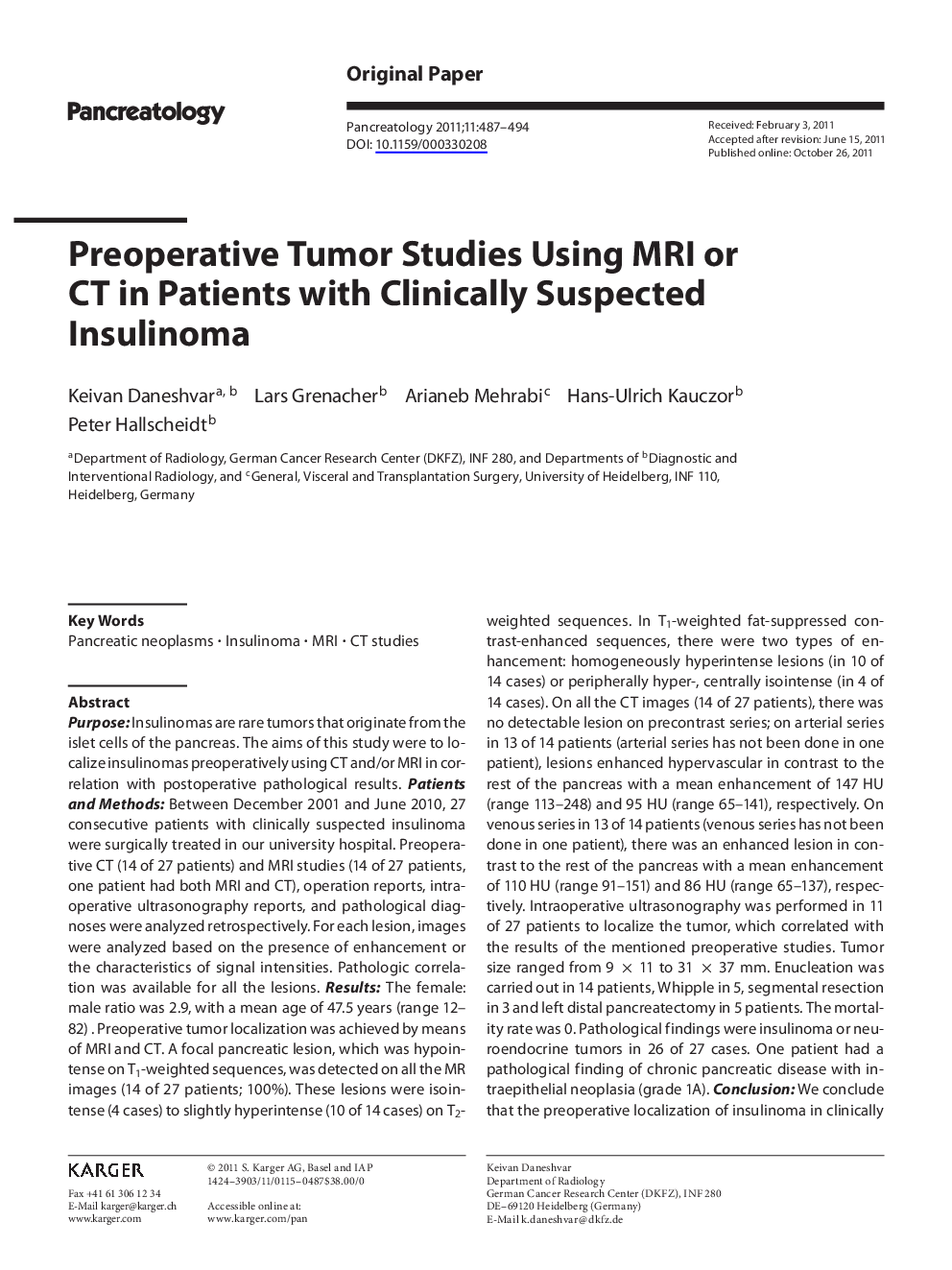| Article ID | Journal | Published Year | Pages | File Type |
|---|---|---|---|---|
| 3318129 | Pancreatology | 2011 | 9 Pages |
Abstract
Purpose: Insulinomas are rare tumors that originate from the islet cells of the pancreas. The aims of this study were to localize insulinomas preoperatively using CTand/or MRI in correlation with postoperative pathological results. Patients and Methods: Between December 2001 and June 2010, 27 consecutive patients with clinically suspected insulinoma were surgically treated in our university hospital. Preoperative CT (14 of 27 patients) and MRI studies (14 of 27 patients, one patient had both MRI and CT), operation reports, intraoperative ultrasonography reports, and pathological diagnoses were analyzed retrospectively. For each lesion, images were analyzed based on the presence of enhancement or the characteristics of signal intensities. Pathologic correlation was available for all the lesions. Results: The female: male ratio was 2.9, with a mean age of 47.5 years (range 12-82). Preoperative tumor localization was achieved by means of MRI and CT. A focal pancreatic lesion, which was hypointense on T1-weighted sequences, was detected on all the MR images (14 of 27 patients; 100%). These lesions were isointense (4 cases) to slightly hyperintense (10 of 14 cases) on T2-weighted sequences. In T1-weighted fat-suppressed contrast-enhanced sequences, there were two types of enhancement: homogeneously hyperintense lesions (in 10 of 14 cases) or peripherally hyper-, centrally isointense (in 4 of 14 cases). On all the CT images (14 of 27 patients), there was no detectable lesion on precontrast series; on arterial series in 13 of 14 patients (arterial series has not been done in one patient), lesions enhanced hypervascular in contrast to the rest of the pancreas with a mean enhancement of 147 HU (range 113-248) and 95 HU (range 65-141), respectively. On venous series in 13 of 14 patients (venous series has not been done in one patient), there was an enhanced lesion in contrast to the rest of the pancreas with a mean enhancement of 110 HU (range 91-151) and 86 HU (range 65-137), respectively. Intraoperative ultrasonography was performed in 11 of 27 patients to localize the tumor, which correlated with the results of the mentioned preoperative studies. Tumor size ranged from 9 Ã 11 to 31 Ã 37 mm. Enucleation was carried out in 14 patients, Whipple in 5, segmental resection in 3 and left distal pancreatectomy in 5 patients. The mortality rate was 0. Pathological findings were insulinoma or neuroendocrine tumors in 26 of 27 cases. One patient had a pathological finding of chronic pancreatic disease with intraepithelial neoplasia (grade 1A). Conclusion: We conclude that the preoperative localization of insulinoma in clinically suspected patients can be made on the basis of MRI and/or CT studies. A hallmark lesion is hypointense in T1-weighted sequences, homogeneously or peripherally hyperintense in T1-weighted fat-suppressed contrast-enhanced sequence using MRI (100% of cases) or/and a hypervascular enhanced lesion on arterial (100% of CT studies) and on venous series using CT (66.7% of CT studies).
Keywords
Related Topics
Health Sciences
Medicine and Dentistry
Gastroenterology
Authors
Keivan Daneshvar, Lars Grenacher, Arianeb Mehrabi, Hans-Ulrich Kauczor, Peter Hallscheidt,
